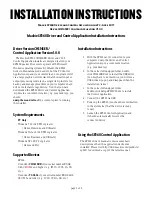
MM200-M MiniCard
What is Wireless LAN?
Wireless Local Area Network (WLAN) systems offer a great number of advantages over traditional wired
systems. WLANs are flexible and easy to setup and manage. They are also more economical than wired
LAN systems.
Using radio frequency (RF) technology, WLANs transmit and receive data through the air. WLANs com-
bine data connectivity with user mobility. For example, users can roam from a conference room to their
office without being disconnected from the LAN.
Using WLANs, users can conveniently access shared information, and network administrators can con-
figure and augment networks without installing or moving network cables.
WLAN technology provides users with many convenient and cost saving features:
x
Mobility:
WLANs provide LAN users with access to real-time information anywhere in their organi-
zation, providing service opportunities that are impossible with wired networks.
x
Ease of Installation:
Installing is easy for novice and expert users alike, eliminating the need to
install network cables in walls and ceilings.
x
Scalability
: WLANs can be configured in a variety of topologies to adapt to specific applications
and installations. Configurations are easily changed and range from peer-to-peer networks suitable
for a small number of users to full infrastructure networks of thousands of users roaming over a
broad area.
LAN Modes
Wireless LANs can be configured in one of two ways:
Table 1: LAN modes
Ad-hoc
Networking
Also known as a peer-to-peer network, an ad-hoc net-
work is one that allows all workstations and computers
in the network to act as servers to all other users on the
network. Users on the network can share files, print to
a shared printer, and access the Internet with a shared
modem. However, with ad-hoc networking, users can
only communicate with other wireless LAN computers
that are in the wireless LAN workgroup, and are within
range.
Infrastructure
Networking
Infrastructure networking differs from ad-hoc network-
ing in that it includes an access point. Unlike the ad-
hoc structure where users on the LAN contend the
shared bandwidth, on an infrastructure network the
access point can manage the bandwidth to maximize
bandwidth utilization.
Additionally, the access point enables users on a wire-
less LAN to access an existing wired network, allowing
wireless users to take advantage of the wired networks
resources, such as Internet, email, file transfer, and
printer sharing.
Infrastructure networking has the following advantages
over ad-hoc networking:
x
Extended range:
each wireless LAN computer
within the range of the access point can commu-
nicate with other wireless LAN computers within
range of the access point.
x
Roaming:
the access point enables a wireless
LAN computer to move through a building and still
be connected to the LAN.
x
Wired to wireless LAN connectivity:
the access
point bridges the gap between wireless LANs and
their wired counterparts.
2






































